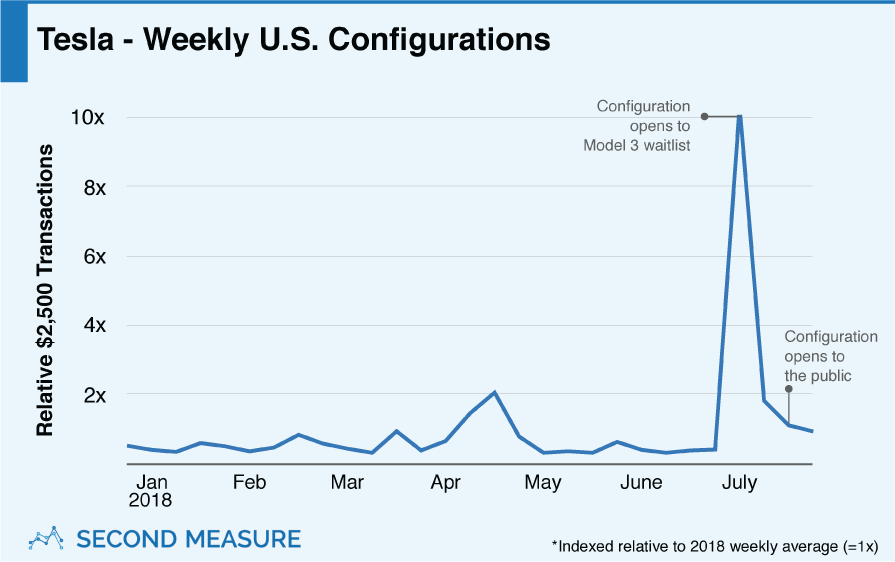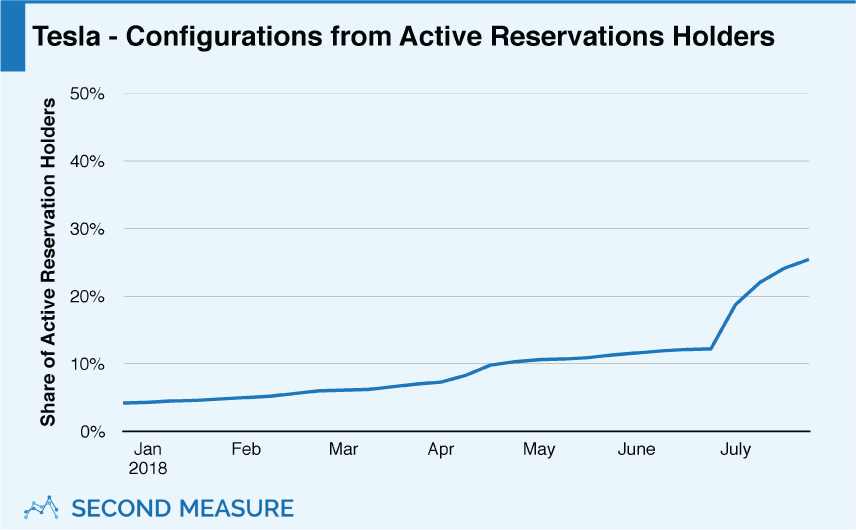NOTE: Bloomberg Second Measure launched a new and exclusive transaction dataset in July 2022. Our data continues to be broadly representative of U.S. consumers. As a result of this panel change, however, we recommend using only the latest posts in assessing metrics, and do not support referring to historical blog posts to infer period-over-period comparisons.
Tesla’s Q2 earnings call left Wall Street with high hopes, and recent talk of taking the company private sent the company’s stock higher still. Manufacturing has caught its stride, and Tesla claims it can sell enough inventory to make money next quarter. As more Americans have been offered the opportunity to put down $2,500 and commit to purchasing a Model 3, reservation holders from the waitlist were most eager to configure a car, while the general public has shown less enthusiasm.
For more than two years, Tesla allowed customers to reserve their spots in the Model 3 queue with a refundable $1,000 deposit. As production delays grew, deposit cancellations reached 23 percent in April, which doesn’t include refunds that are delayed or issued as checks. Refunds have continued to rise, though the same is true of configuration payments—a second deposit made when the buyer commits to purchase and selects features.
As Model 3s entered the market late last year, Tesla notified early reservation holders individually when it was their turn to configure a car. Then, on June 28, Tesla began accepting $2,500 Model 3 configuration deposits from everyone on its waitlist. That week, among reservation holders who hadn’t previously received a refund or configured a Tesla, 7 percent took the bait.

Then, on July 10, Tesla extended the same offer to the general public, but demand was just a fraction of what it was at the end of June. Tesla received one-tenth as many configuration payments as two weeks prior.
Most of the Model 3 waitlist is still waiting
The Model 3’s massive waitlist would, presumably, lead to a slew of easy sales, but most of the waitlist has yet to commit to purchase. Our analysis looked at the Model 3’s active reservation holders, meaning that refunded depositors are not counted. With refunds out of the equation, one would expect that the vast majority of reservation holders intend to make a purchase. But, three weeks into July, only 25 percent had configured a Tesla. These findings may exclude some customers who used different payment methods for the deposit and configuration.

After waiting up to two years, why aren’t more people from the waitlist clamoring to order their Model 3s? One reason may be that Tesla has removed all trace of the long-awaited $35,000 build from its website. Some suspect the baseline Model 3, which was touted as an affordable electric vehicle for the masses, may never materialize. Instead, Tesla appears to be positioning the Model 3, which currently starts at $49,000, to compete with luxury car brands.
How high have Tesla Model 3 refunds climbed? Get in touch to find out.
Oh, and we’re hiring.
